Mapping of Ecological Corridors as Connections between Protected Areas: A Study Concerning Sardinia, Italy
Abstract
:1. Introduction
2. Materials and Methods
2.1. Study Area
2.2. Spatial Identification of the Ecological Corridors
- definition of a habitat-suitability map;
- definition of an ecological-integrity map;
- definition of a resistance map;
- spatial identification of ECs.
2.3. Relation between ECs and Landscape Components
- natural and subnatural areas, which include: scrub vegetation in dry areas and wetlands (areas covered with sparse vegetation, between 5% and 40%; riparian areas covered with non–arboreal vegetation; Mediterranean scrub; river beds larger than 25 m; inland marshes; salt marshes; rock faces); and, woodlands (mixed coniferous and broadleaf woods; broadleaf woods);
- seminatural areas, which include: grasslands (steady meadows; natural pastures; thickets and shrublands; garrigues; natural recolonization areas); and, cork and chestnut woods;
- areas dedicated to agriculture and forestry, which include: specialized and tree crops (vineyards; orchards; temporary olive– and vineyard–related crops; temporary crops related to other permanent crops); artificial woods (coniferous woods; poplar, willow and eucalypt woods; other trees for timber; arboriculture with coniferous forest trees; artificial recolonization areas); and, specialized herbaceous crops, agricultural and forest areas, and uncultivated areas (non–irrigated arable land; artificial meadows; simple arable land and full-field horticultural crops; paddies; breeding grounds; greenhouse crops; complex parcel cropping systems; areas characterized by prevailing agricultural crops and residual important natural land; uncultivated areas).
- ECWD is the CWD of a patch included in an EC;
- SCRB is for scrub vegetation in dry areas and wetlands;
- WOOD is for woodlands;
- GRAS is for grasslands;
- CCHW is for cork and chestnut woods;
- SPTC is for specialized and tree crops;
- ARWO is for artificial woods;
- HAFU is for specialized herbaceous crops, agricultural and forest areas, and uncultivated areas;
- ALTD is a control variable that represents the average altitude in an EC.
3. Results
3.1. The Spatial Layout of Ecological Corridors
3.2. Discussion on the Overlay of Ecological Corridors and Landscape Components
4. Discussion
5. Conclusions
Author Contributions
Funding
Conflicts of Interest
References
- D’Ambrogi, S.; Gori, M.; Guccione, M.; Nazzini, L. Implementazione della connettività ecologica sul territorio: Il monitoraggio ISPRA 2014 [The implementation of spatial ecological connectivity: The 2014 Monitoring of ISPRA]. Reticula 2015, 9, 1–7. Available online: https://www.isprambiente.gov.it/it/pubblicazioni/periodici-tecnici/reticula/Reticula_n9.pdf (accessed on 19 April 2022).
- D’Ambrogi, S.; Nazzini, L. Monitoraggio ISPRA 2012: La rete ecologica nella pianificazione territoriale [The 2012 Monitoring of ISPRA: The ecological network applied to spatial planning]. Reticula 2013, 3, 1–5. Available online: Isprambiente.gov.it/files/pubblicazioni/periodicitecnici/reticula/Reticula_n3.pdf (accessed on 19 April 2022).
- Battisti, C. Frammentazione Ambientale, Connettività, Reti Ecologiche. Un Contributo Teorico e Metodologico con Particolare Riferimento alla Fauna Selvatica [Environmental Fragmentation, Connectivity, Ecological Networks. A Technical and Methodological Contribution with Particolar Reference to Wildlife Species]; Provincia di Roma, Assessorato delle Politiche Ambientali; Agricoltura e Protezione Civile [Province of Rome, Board of Envionmental Policy, Agriculture and Civil Protection]: Rome, Italy, 2004. [Google Scholar]
- Baudry, J.; Merriam, H.G. Connectivity and connectedness: Functional versus structural patterns in landscapes. In Proceedings of the 2nd IALE Seminar “Connectivity in Landscape Ecology”, Münster, Germany, 19–24 July 1987; Münsterche Geographische Arbeiten: Münster, Germany, 1988; Volume 29, pp. 23–28. [Google Scholar]
- European Commission. Communication from the Commission to the European Parliament, the Council, the European Economic and Social Committee and the Committee of the Regions. Green Infrastructure—Enhancing Europe’s Natural Capital. SWD (2013) 155 Final. 2013. Available online: https://eur-lex.europa.eu/legal-content/EN/TXT/PDF/?uri=CELEX:52013DC0249&from=EN (accessed on 19 April 2022).
- Liquete, C.; Kleeschulte, S.; Dige, G.; Maes, J.; Grizzetti, B.; Olah, B.; Zulian, G. Mapping green infrastructure based on ecosystem services and ecological networks: A Pan–European case study. Environ. Sci. Policy 2015, 54, 268–280. [Google Scholar] [CrossRef]
- Directorate–General Environment, European Commission. The Multifunctionality of Green Infrastructure, Science for Environment Policy, DG News Alert Service, In–depth Report. 2012. Available online: https://ec.europa.eu/environment/nature/ecosystems/docs/Green_Infrastructure.pdf (accessed on 19 April 2022).
- European Environment Agency. Spatial Analysis of Green Infrastructure in Europe; EEA Technical Report no. 2/2014; Publications Office of the European Union: Luxembourg, 2014. [Google Scholar] [CrossRef]
- Taylor, P.D.; Fahrig, L.; Henein, K.; Merriam, G. Connectivity is a vital element of landscape structure. Oikos 1993, 68, 571–573. [Google Scholar] [CrossRef] [Green Version]
- Dunning, J.B.; Danielson, J.B.; Pulliam, H.R. Ecological processes that affect populations in complex landscapes. Oikos 1992, 65, 169–175. [Google Scholar] [CrossRef] [Green Version]
- With, K.A.; Gardner, R.H.; Turner, M.G. Landscape connectivity and population distributions in heterogeneous environments. Oikos 1997, 78, 151–169. [Google Scholar] [CrossRef] [Green Version]
- Issii, T.M.; Lopes Pereira-Silva, E.F.; López de Pablo, C.T.; Ferreira dos Santos, R.; Hardt, E. Is there an equivalence between measures of landscape structural and functional connectivity for plants in conservation assessments of the Cerrado? Land 2020, 9, 459. [Google Scholar] [CrossRef]
- Tischendorf, L.; Fahrig, L. On the usage and measurement of landscape connectivity. Oikos 2000, 90, 7–19. [Google Scholar] [CrossRef] [Green Version]
- Balbi, M.; Petit, E.J.; Corci, S.; Nabucet, J.; Georges, R.; Madec, L.; Ernoult, A. Title: Ecological relevance of least cost path analysis: An easy implementation method for landscape urban planning. J. Environ. Manag. 2019, 244, 61–68. [Google Scholar] [CrossRef]
- Simberloff, D.; Farr, J.A.; Mehlman, D.W. Movement corridors: Conservation bargains or poor investments? Conserv. Biol. 1992, 6, 493–504. [Google Scholar] [CrossRef]
- Saunders, D.A.; Hobbs, R.J. The role of corridors in conservation: What do we know and where do we go? In Nature Conservation 2: The Role of Corridors; Saunders, D.A., Hobbs, R.J., Eds.; Surrey Beatty & Sons: Chipping Norton, NSW, Australia, 1991. [Google Scholar]
- Rosenberg, D.K.; Noon, B.R.; Meslow, E.C. Towards a Definition of “Biological Corridor”. In Integrating People and Wildlife for a Sustainable Future, Proceedings of the International Wildlife Management Congress; Bissonette, J.A., Krausman, P.R., Eds.; The Wildlife Society: Bethesda, MD, USA, 1995. [Google Scholar]
- Hess, G.R.; Fischer, R.A. Communicating clearly about conservation corridors. Landsc. Urban Plan. 2001, 55, 195–208. [Google Scholar] [CrossRef]
- MacArthur, R.H.; Wilson, E.O. The Theory of Island Biogeography; Princeton University Press: Princeton, NJ, USA, 1967. [Google Scholar]
- Levins, R. Some Demographic and genetic consequences of environmental heterogeneity for biological control. Bull. Entomol. Soc. Am. 1969, 15, 237–240. [Google Scholar] [CrossRef]
- Zeller, K.A.; McGarigal, K.; Whiteley, A.R. Estimating landscape resistance to movement: A review. Landsc. Ecol. 2012, 27, 777–797. [Google Scholar] [CrossRef]
- McRae, B.H.; Dickson, B.G.; Keitt, T.H.; Shah, V.B. Using circuit theory to model connectivity in ecology, evolution, and conservation. Ecology 2008, 89, 2712–2724. [Google Scholar] [CrossRef]
- Palmer, S.C.F.; Coulon, A.; Travis, J.M.J. Introducing a ‘stochastic movement simulator’ for estimating habitat connectivity. Methods Ecol. Evol. 2011, 2, 258–268. [Google Scholar] [CrossRef]
- Wu, J.; Delang, C.O.; Li, Y.; Ye, Q.; Zhou, J.; Liu, H.; He, H.; He, W. Application of a combined model simulation to determine ecological corridors for western black-crested gibbons in the Hengduan Mountains, China. Ecol. Indic. 2021, 128, 107826. [Google Scholar] [CrossRef]
- Guo, X.; Zhang, X.; Du, S.; Li, C.; Siu, Y.L.; Rong, Y.; Yang, H. The impact of onshore wind power projects on ecological corridors and landscape connectivity in Shanxi, China. J. Clean. Prod. 2020, 254, 120075. [Google Scholar] [CrossRef]
- Lai, S.; Leone, F.; Zoppi, C. Land cover changes and environmental protection: A study based on transition matrices concerning Sardinia (Italy). Land Use Policy 2017, 67, 126–150. [Google Scholar] [CrossRef]
- Cannas, I.; Zoppi, C. Ecosystem services and the Natura 2000 Network: A study concerning a green infrastructure based on ecological corridors in the Metropolitan City of Cagliari. In 17th International Conference on Computational Science and Its Applications (IC-CSA 2017); Lecture Notes in Computer Sciences Series; Gervasi, O., Murgante, B., Misra, S., Borruso, G., Torre, C., Rocha, A.M.A.C., Taniar, D., Apduhan, B.O., Stankova, E., Cuzzocrea, A., Eds.; Springer: Cham, Switzerland, 2017; Volume 10409, pp. 379–400. [Google Scholar] [CrossRef]
- Cannas, I.; Zoppi, C. Un’infrastruttura verde nell’area metropolitana di Cagliari: Corridoi ecologici come connessioni tra i Siti della Rete Natura 2000 [A Green Infrastructure in the Metropolitan Area of Cagliari: Ecological Corridors as Connections between the Sites of the Natura 2000 Network]. In Atti Della XX Conferenza Nazionale SIU. Urbanistica E/È Azione Pubblica [Proceedings of the 20th National Conference of SIU. Spatial Planning And/Is Public Action]; AA.VV.; Planum Publisher: Rome/Milan, Italy, 2017; pp. 1373–1386. [Google Scholar]
- Cannas, I.; Lai, S.; Leone, F.; Zoppi, C. Green infrastructure and ecological corridors: A regional study concerning Sardinia. Sustainability 2018, 10, 1265. [Google Scholar] [CrossRef] [Green Version]
- Cannas, I.; Lai, S.; Leone, F.; Zoppi, C. Integrating green infrastructure and ecological corridors: A Study concerning the Metropolitan Area of Cagliari (Italy). In Smart Planning: Sustainability and Mobility in the Age of Change; Papa, R., Fistola, R., Gargiulo, C., Eds.; Springer International Publishing: Basel, Switzerland, 2018; pp. 127–145. [Google Scholar] [CrossRef]
- Subsection 2.1 Study Area builds on: Lai, S.; Leone, F.; Zoppi, C. Anthropization processes and protection of the environment: An assessment of land cover changes in Sardinia, Italy. Sustainability 2017, 9, 2174, Subsection 3.1. Study Area and Protection Levels, pp. 3–4 (written by Sabrina Lai). [Google Scholar] [CrossRef] [Green Version]
- European Commission. The Natura 2000 Biogeographical Regions. 2016. Available online: http://ec.europa.eu/environment/nature/natura2000/biogeog_regions/ (accessed on 19 April 2022).
- Council of Europe—Directorate of Culture and Cultural and Natural Heritage. Biogeographical Regions’ Map. 2010. Available online: https://rm.coe.int/168074623f (accessed on 19 April 2022).
- Directorate–General Environment, European Commission. Natura 2000 Barometer. 2016. Available online: https://ec.europa.eu/environment/nature/natura2000/barometer/index_en.htm (accessed on 19 April 2022).
- Data Available at the Website. Available online: https://www.eea.europa.eu/data-and-maps/data/natura-13/natura-2000-spatial-data/natura-2000-shapefile-1 (accessed on 19 April 2022).
- Sawyer, S.C.; Epps, C.W.; Brashares, J.S. Placing linkages among fragmented habitats: Do least-cost models reflect how animals use landscapes? J. Appl. Ecol. 2011, 48, 668–678. [Google Scholar] [CrossRef]
- Adriaensen, F.; Chardon, J.P.; De Blust, G.; Swinnen, E.; Villalba, S.; Gulinck, H.; Matthysen, E. The application of “least-cost” modelling as a functional landscape model. Landsc. Urban Plan. 2003, 64, 233–247. [Google Scholar] [CrossRef]
- Coulon, A.; Aben, J.; Palmer, S.C.F.; Stevens, V.M.; Callens, T.; Strubbe, D.; Travis, J.M.J. A stochastic movement simulator improves estimates of landscape connectivity. Ecology 2015, 96, 2203–2213. [Google Scholar] [CrossRef] [PubMed] [Green Version]
- Osborn, F.V.; Parker, G.E. Linking two elephant refuges with a corridor in the communal lands of Zimbabwe. Afr. J. Ecol. 2003, 41, 68–74. [Google Scholar] [CrossRef]
- Kong, F.; Yin, Y.; Nakagoshi, N.; Zong, Y. Urban green space network development for biodiversity conservation: Identification based on graph theory and gravity modeling. Landsc. Urban Plan. 2010, 95, 16–27. [Google Scholar] [CrossRef]
- Larkin, J.L.; Maehr, D.S.; Hoctor, T.S.; Orlando, M.A.; Whitney, K. Landscape linkages and conservation planning for the black bear in westcentral Florida. Anim. Conserv. 2004, 7, 23–34. [Google Scholar] [CrossRef] [Green Version]
- AGRISTUDIO; CRITERIA; TEMI. Realizzazione del Sistema di Monitoraggio dello Stato di Conservazione degli Habitat e delle Specie di Interesse Comunitario della Regione Autonoma della Sardegna. Relazione Generale, Allegato 1b: Carta dell’Idoneità Faunistica [Implementation of the Monitoring System Concerning the Conservation Status of Habitats and Species of Community Interest of the Autonomous Region of Sardinia. General Report, Attachment 1b: Habitat Suitability Map]. MIMEO. Unpublished work. 2011. [Google Scholar]
- Burkhard, B.; Kroll, F.; Müller, F.; Windhorst, W. Landscapes’ capacities to provide ecosystem services—A concept for land-cover based assessments. Landsc. Online 2009, 15, 1–22. [Google Scholar] [CrossRef]
- Burkhard, B.; Kroll, F.; Nedkov, S.; Müller, F. Mapping ecosystem service supply, demand and budgets. Ecol. Indic. 2012, 2, 7–29. [Google Scholar] [CrossRef]
- LaRue, M.A.; Nielsen, C.K. Modelling potential dispersal corridors for cougars in Midwestern North America using least-cost path methods. Ecol. Model. 2008, 212, 372–381. [Google Scholar] [CrossRef]
- McRae, B.H.; Kavanagh, D.M. User Guide: Linkage Pathways Tool of the Linkage Mapper Toolbox—Version 2.0—Updated October 2017. 2017. Available online: https://github.com/linkagescape/linkage-mapper/files/2204107/Linkage_Mapper_2_0_0.zip (accessed on 19 April 2022).
- Shirabe, T. Buffered or bundled, least-cost paths are not least-cost corridors: Computational experiments on path-based and wide-path-based models to conservation corridor design and effective distance estimation. Ecol. Inform. 2018, 44, 109–116. [Google Scholar] [CrossRef]
- Cheshire, P.; Sheppard, S. On the price of land and the value of amenities. Econ. New Ser. 1995, 62, 247–267. [Google Scholar] [CrossRef]
- Stewart, P.A.; Libby, L.W. Determinants of Farmland Value: The case of DeKalb County, Illinois. Rev. Agric. Econ. 1998, 20, 80–95. [Google Scholar] [CrossRef]
- Sklenicka, P.; Molnarova, K.; Pixova, K.C.; Salek, M.E. Factors affecting farmlands in the Czech Republic. Land Use Policy 2013, 30, 130–136. [Google Scholar] [CrossRef]
- Zoppi, C.; Argiolas, M.; Lai, S. Factors influencing the value of houses: Estimates for the City of Cagliari, Italy. Land Use Policy 2015, 42, 367–380. [Google Scholar] [CrossRef]
- Bera, A.K.; Byron, R.P. Linearised estimation of nonlinear single equation functions. Int. Econ. Rev. 1983, 24, 237–248. [Google Scholar] [CrossRef]
- Wolman, A.L.; Couper, E. Potential consequences of linear approximation in economics. Fed. Reserve Bank Econ. Quartely 2003, 11, 51–67. [Google Scholar]
- Feng, H.; Li, Y.; Li, Y.Y.; Li, N.; Li, Y.; Hu, Y.; Yu, J.; Luo, H. Identifying and evaluating the ecological network of Siberian roe deer (Capreolus pygargus) in Tieli Forestry Bureau, northeast China. Glob. Ecol. Conserv. 2021, 26, e01477. [Google Scholar] [CrossRef]
- Dutta, T.; Sharma, S.; McRae, B.H.; Roy, P.S.; DeFries, R. Connecting the dots: Mapping habitat connectivity for tigers in central India. Reg. Environ. Chang. 2016, 16, 53–67. [Google Scholar] [CrossRef]
- Hyytiainen, K.; Leppanen, J.; Pahkasalo, T. Economic analysis of field afforestation and forest clearance for cultivation in Finland. In Proceedings of the International Congress of European Association of Agricultural Economists, Ghent, Belgium, 26–29 August 2008. [Google Scholar] [CrossRef]
- Sagebiel, J.; Glenk, K.; Meyerhoff, J. Spatially explicit demand for afforestation. For. Policy Econ. 2017, 78, 190–199. [Google Scholar] [CrossRef]
- Hou, Y.; Li, B.; Müller, F.; Fu, Q.; Chen, W. A conservation decision-making framework based on ecosystem service hotspot and interaction analyses on multiple scales. Sci. Total Environ. 2018, 643, 277–291. [Google Scholar] [CrossRef]
- Zavalloni, M.; D’Alberto, R.; Raggi, M.; Viaggi, D. Farmland abandonment, public goods and the CAP in a marginal area of Italy. Land Use Policy 2021, 107, 104365. [Google Scholar] [CrossRef]
- Li, K.; Hou, Y.; Andersen, P.S.; Xin, R.; Rong, Y.; Skov-Petersen, H. Identifying the potential areas of afforestation projects using cost-benefit analysis based on ecosystem services and farmland suitability: A case study of the Grain for Green Project in Jinan, China. Sci. Total Environ. 2021, 787, 147542. [Google Scholar] [CrossRef]
- Feng, Z.; Yang, Y.; Zhang, Y.; Zhang, P.; Li, Y. Grain-for-green policy and its impacts on grain supply in West China. Land Use Policy 2005, 22, 301–312. [Google Scholar] [CrossRef]
- Ryan, M.; O’Donoghue, C. Socio-economic drivers of farm afforestation decision-making. Ir. For. J. 2016, 73, 96–121. [Google Scholar]
- Howley, P.; Buckley, C.; O’Donoghue, C.; Ryan, M. Explaining the economic ‘irrationality’ of farmers’ land use behaviour: The role of productivist attitudes and non-pecuniary benefits. Ecol. Econ. 2015, 109, 186–193. [Google Scholar] [CrossRef]
- Duesberg, S.; Ní Dhubháin, A.; O’Connor, D. Assessing policy tools for encouraging farm afforestation in Ireland. Land Use Policy 2014, 38, 194–203. [Google Scholar] [CrossRef]
- Kumm, K.-I.; Hessle, A. Economic comparison between pasture-based beef production and afforestation of abandoned land in Swedish forest districts. Land 2020, 9, 42. [Google Scholar] [CrossRef] [Green Version]
- Behan, J.; McQuinn, K.; Roche, M.J. Rural land use: Traditional agriculture or forestry? Land Econ. 2006, 82, 112–123. [Google Scholar] [CrossRef]
- Samways, M.J.; Bazelet, C.S.; Pryke, J.S. Provision of ecosystem services by large scale corridors and ecological networks. Biodivers. Conserv. 2010, 19, 2949–2962. [Google Scholar] [CrossRef]
- Millennium Ecosystem Assessment. Ecosystems and Human Well-Being: A Framework for Assessment; Island Press: Washington, DC, USA, 2003. [Google Scholar]
- Kovács, E.; Kelemen, K.; Kalóczkai, A.; Margóczi, K.; Pataki, G.; Gébert, J.; Málovics, G.; Balázs, B.; Roboz, A.; Krasznai Kovács, E.; et al. Understanding the links between ecosystem service trade-offs and conflicts in protected areas. Ecosyst. Serv. 2015, 12, 117–127. [Google Scholar] [CrossRef] [Green Version]

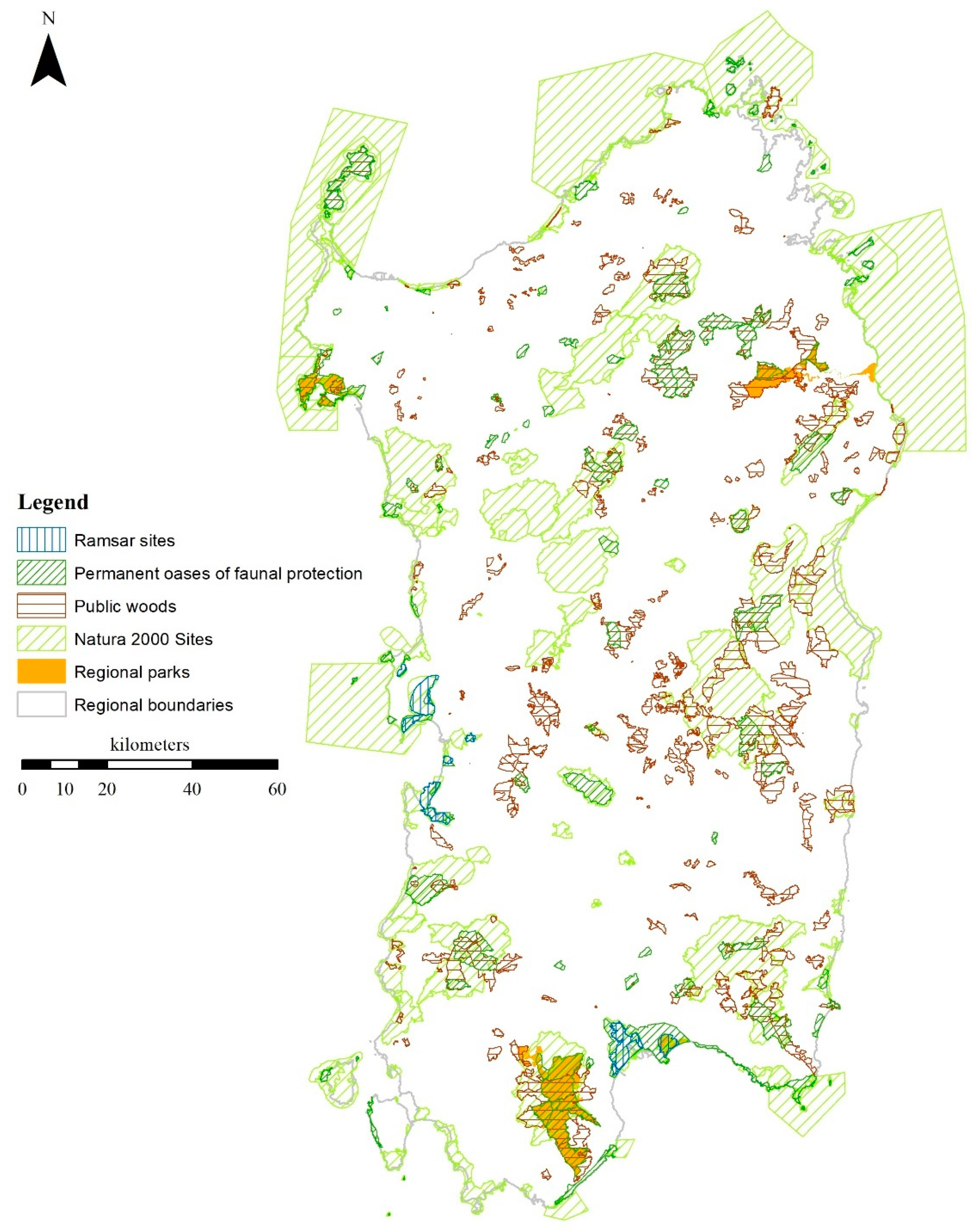
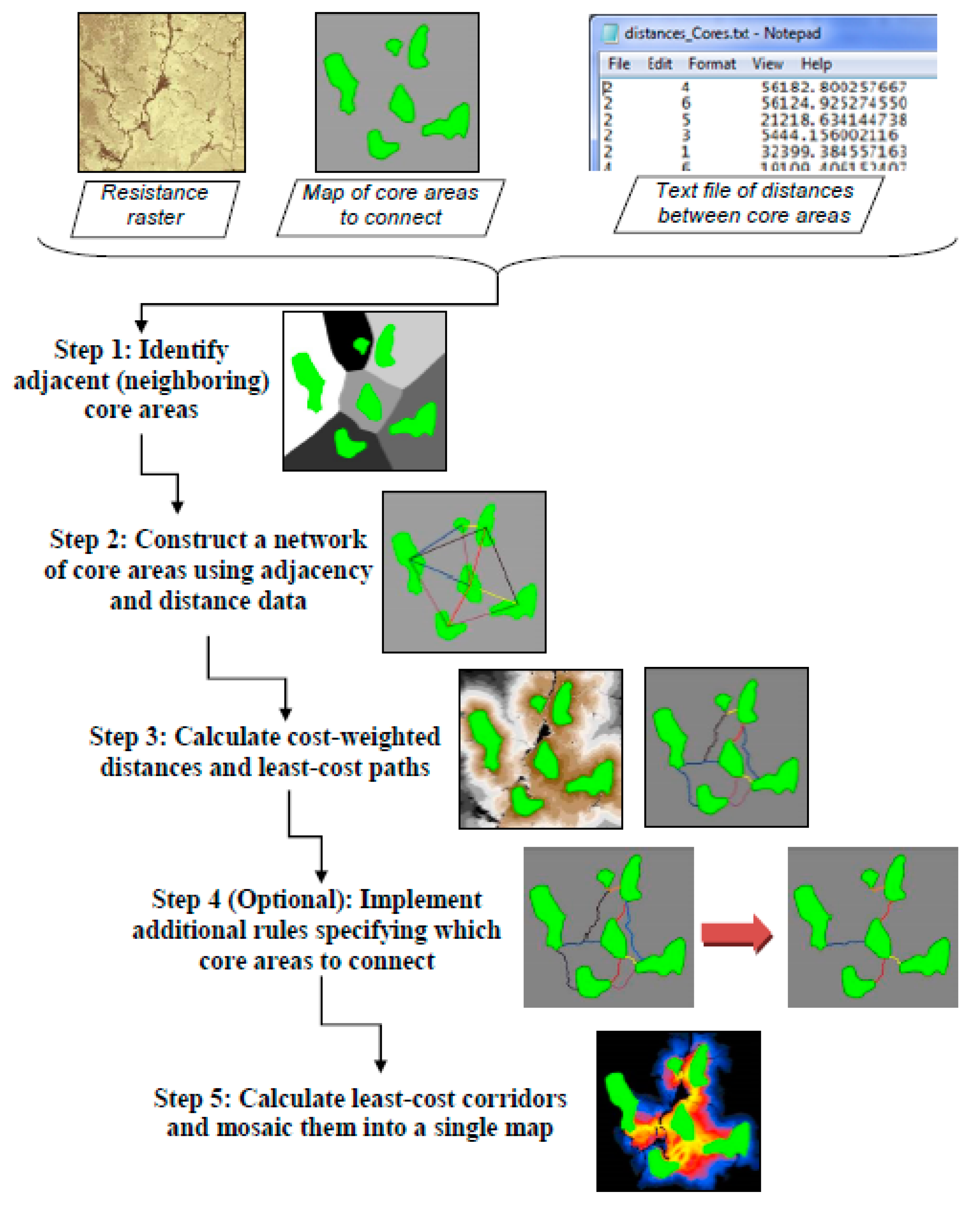


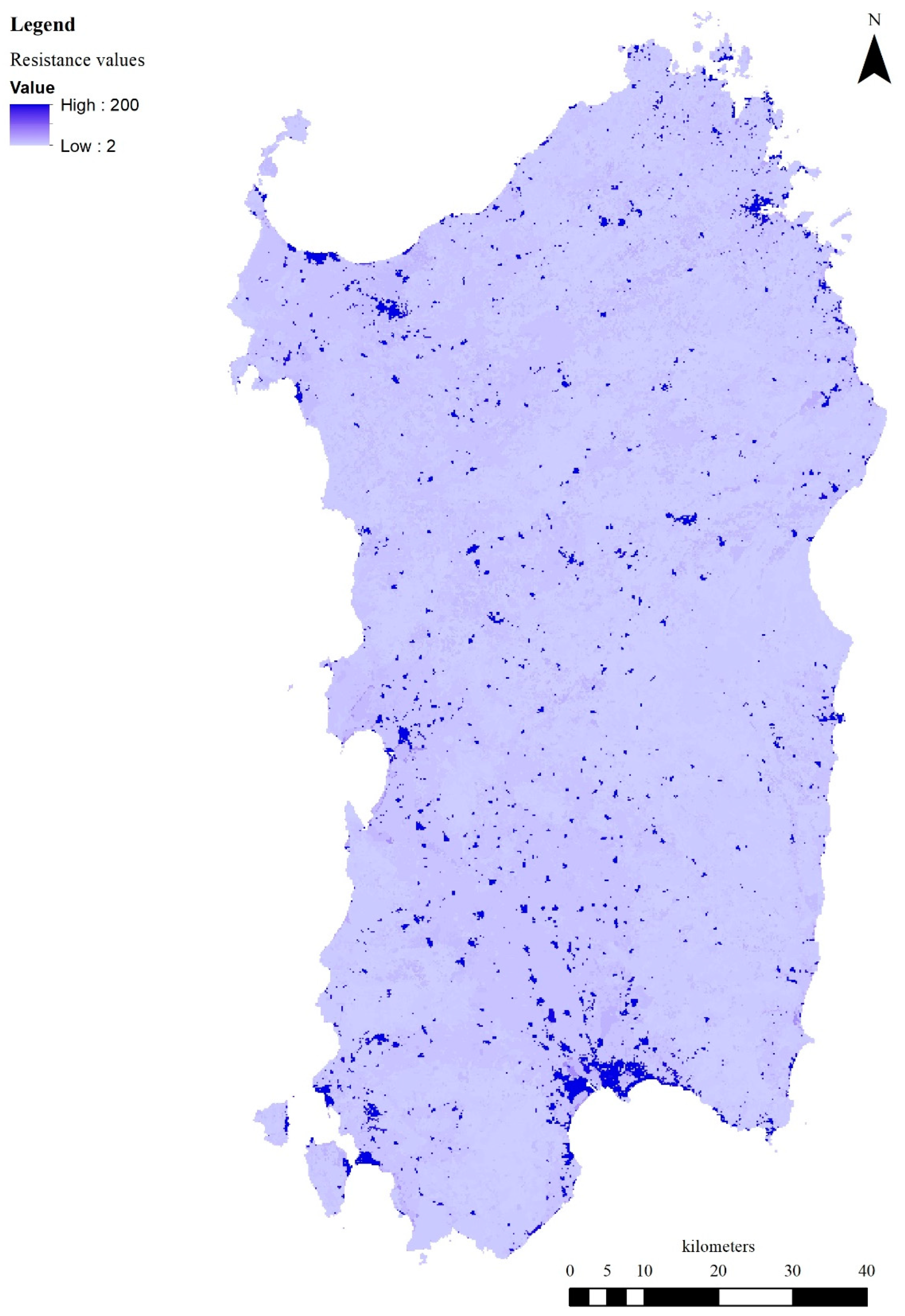
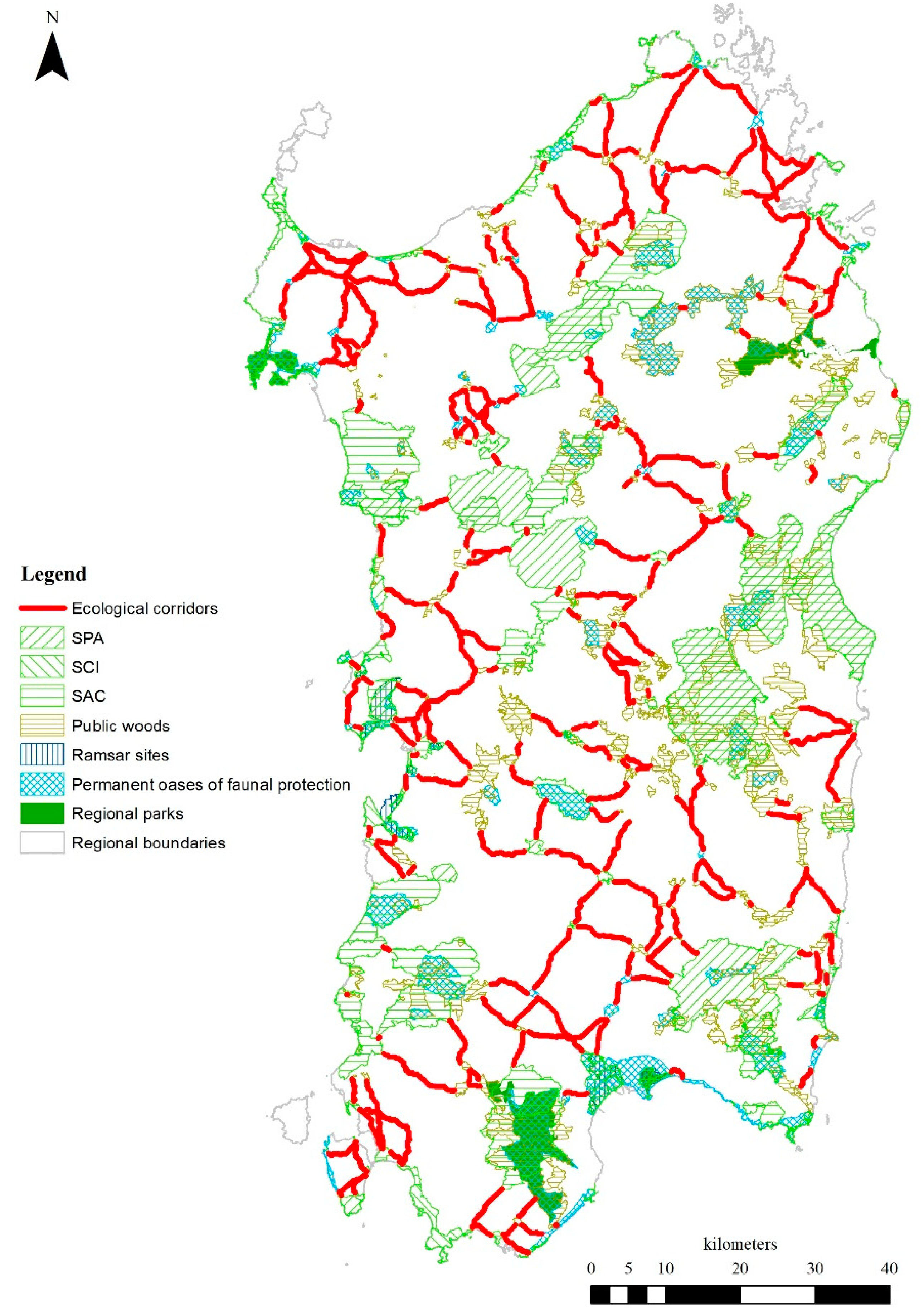
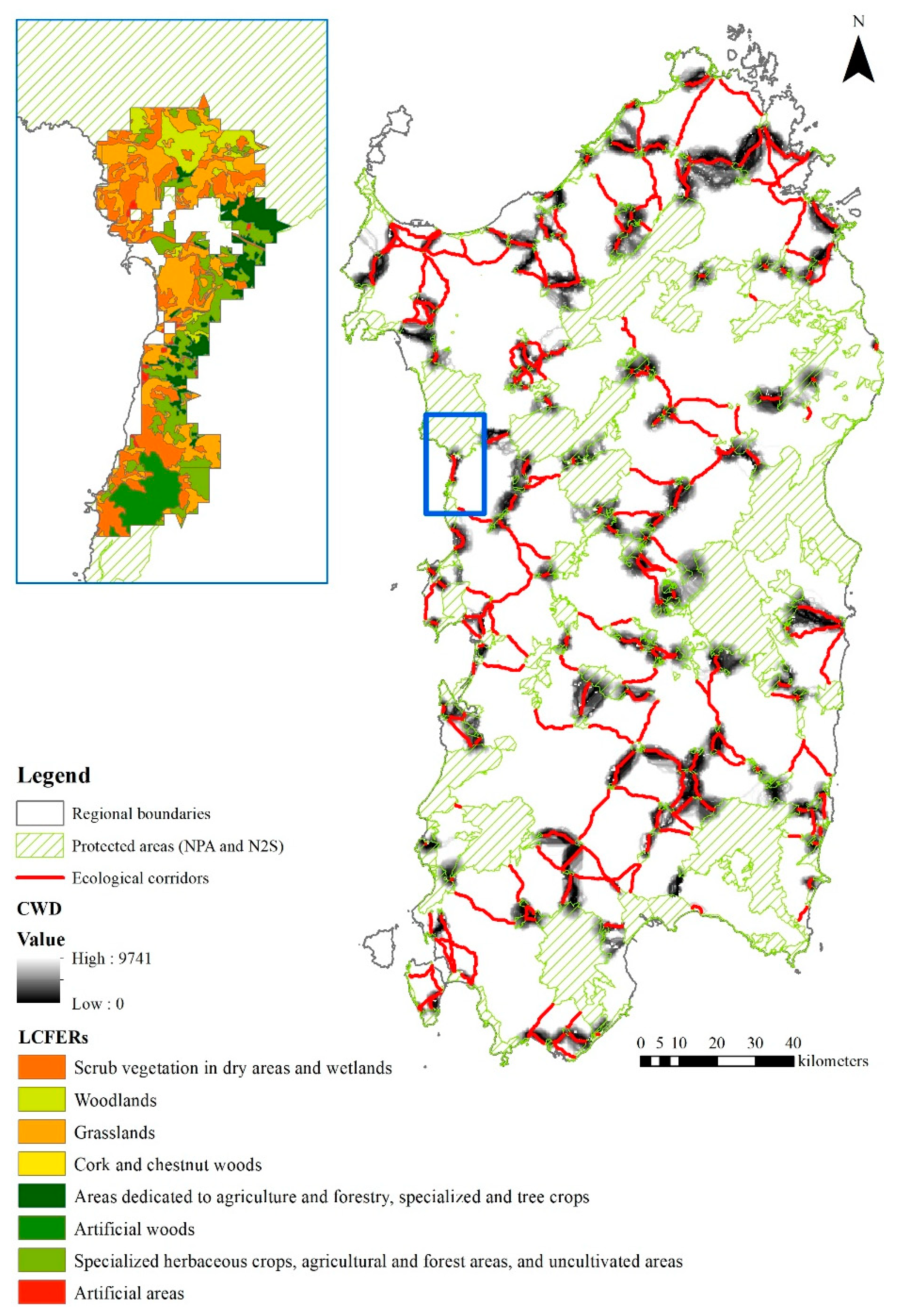
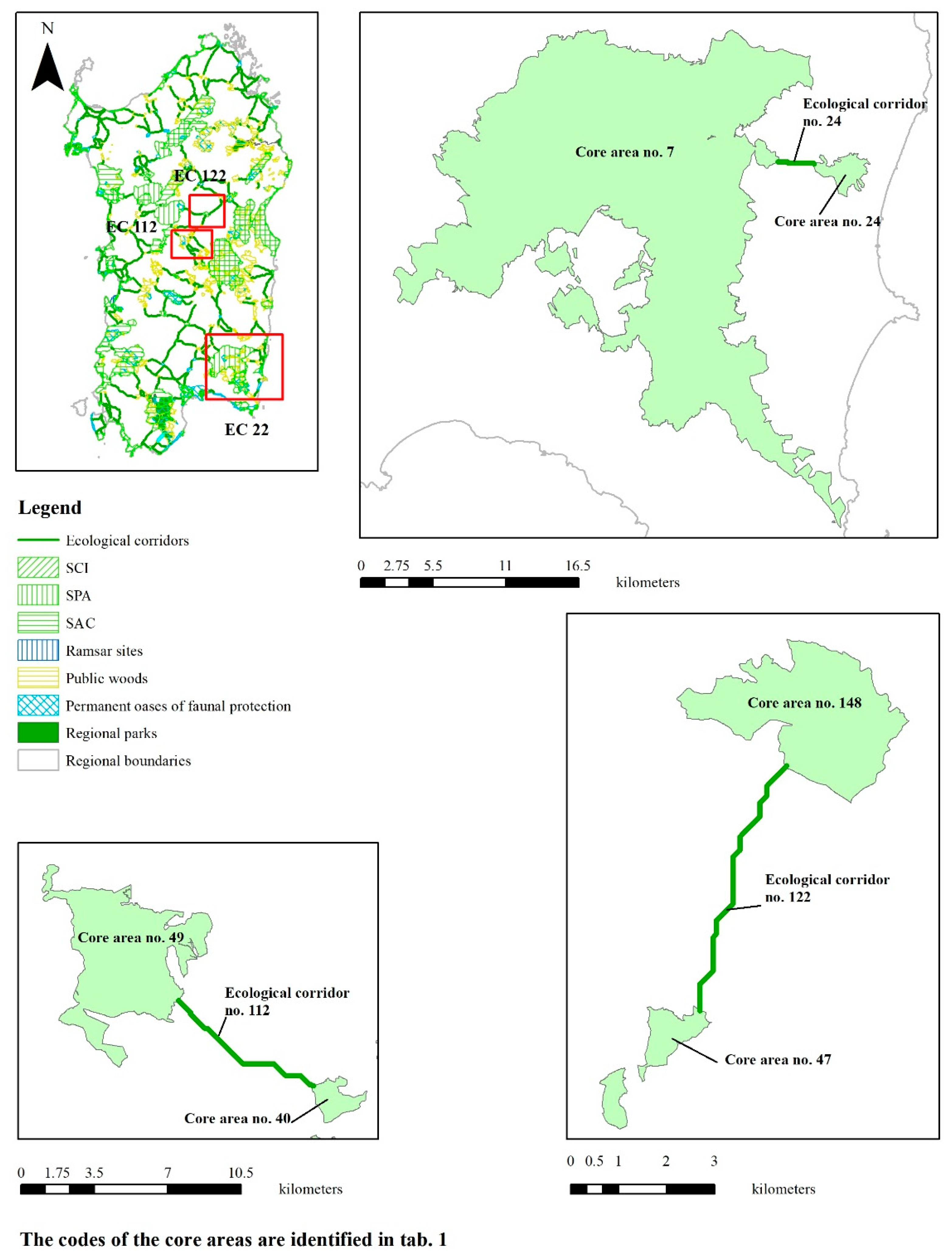

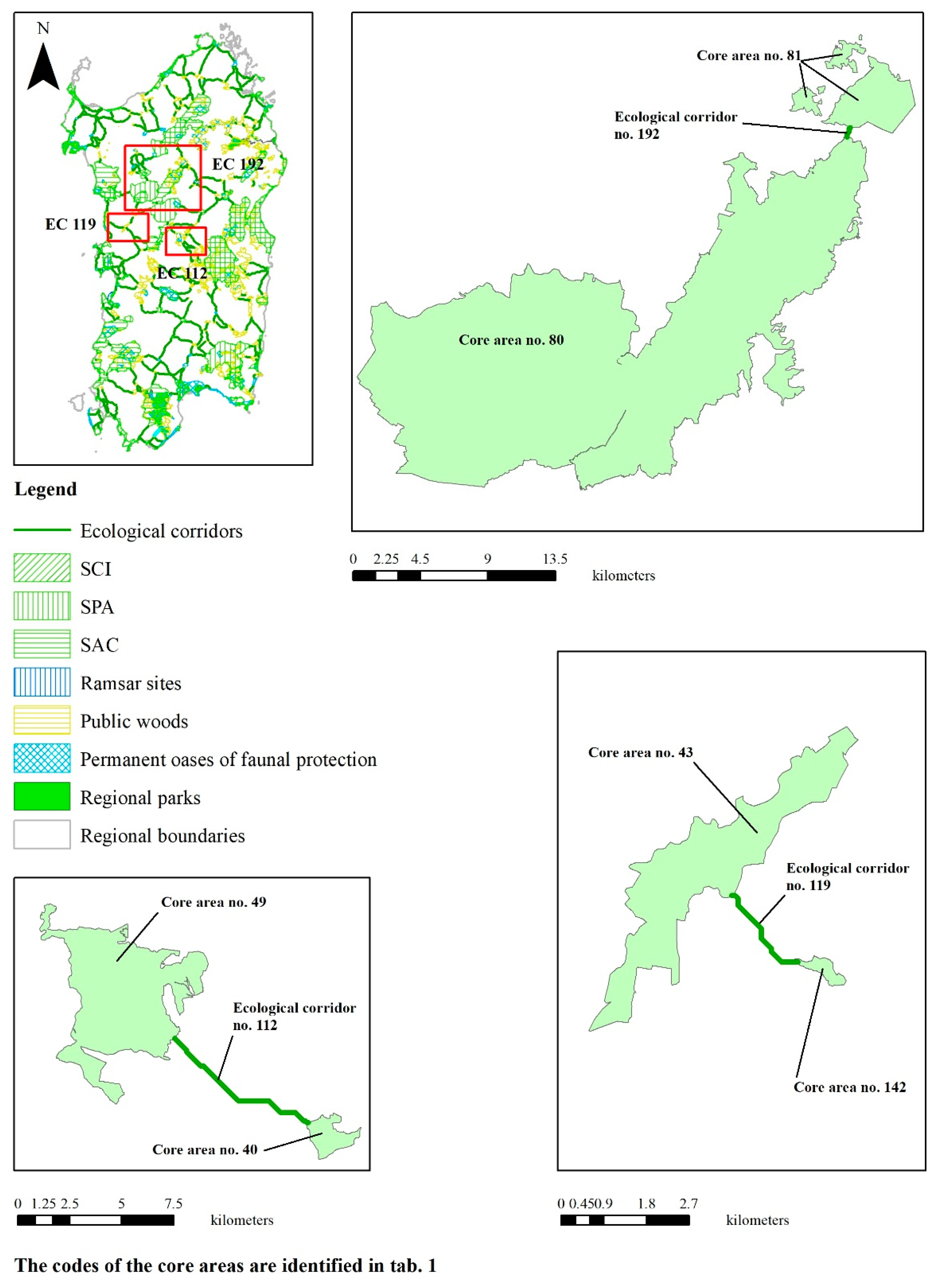
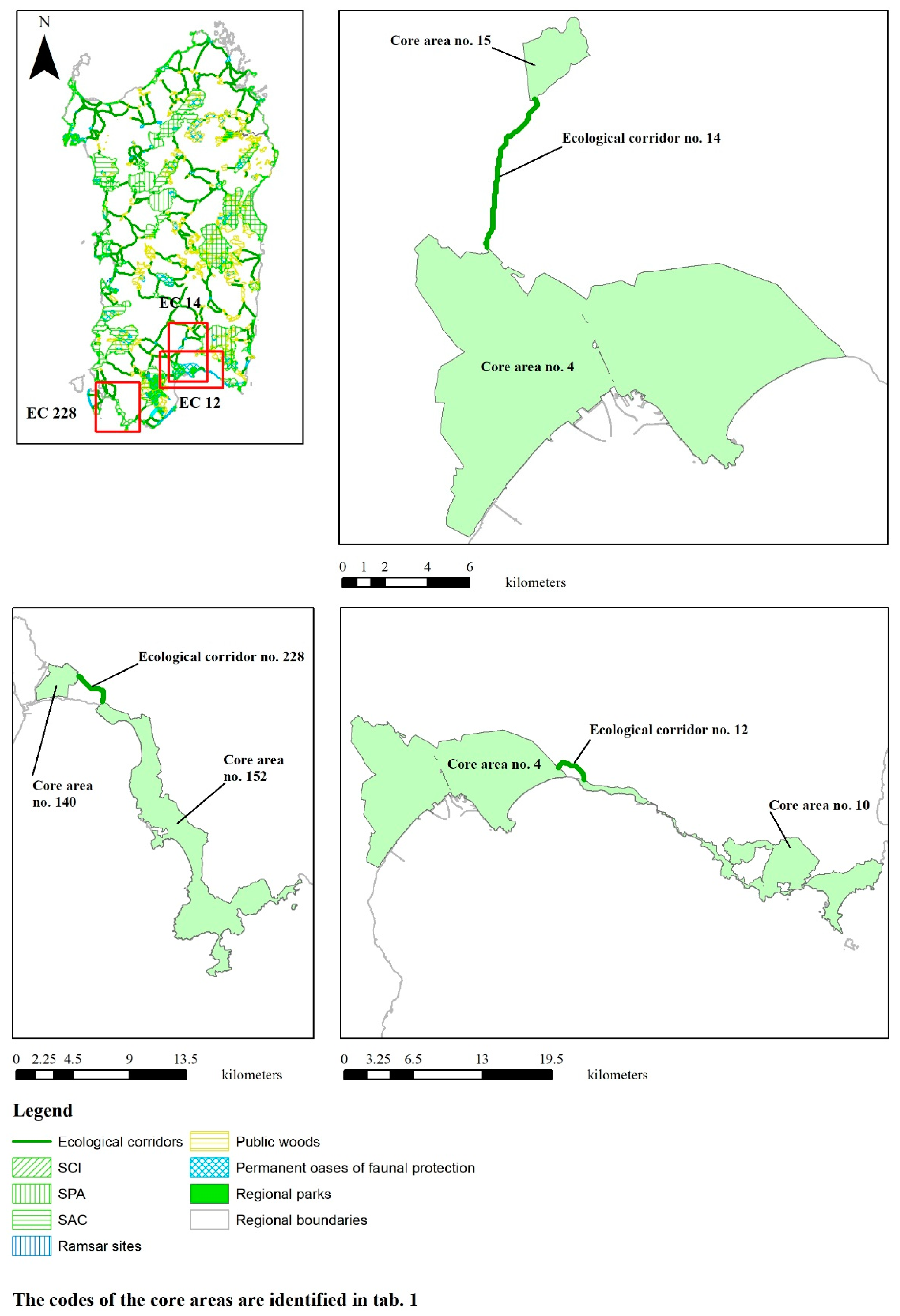
| Data | Description | Year | Source |
|---|---|---|---|
| Sardinian land cover map | Sardinian land cover map is a vector map produced by the Regional Administration of Sardinia, where land covers are classed in relation to four levels. The first three levels report the CLC nomenclature. Linear features include linear entities with a width of less than 25 m, related to roads, railways, and hydrography. As regards polygonal features, the minimum unit mapped is 0.5 hectares within the urban area and 0.75 hectares elsewhere | 2008 | https://www.sardegnageoportale.it/index.php?xsl=2420&s=40&v=9&c=14480&es=6603&na=1&n=100&esp=1&tb=14401 (accessed on 19 April 2022) |
| Species-specific values of habitat suitability | Habitat suitability species-specific values are defined within a study commissioned by the Regional Administration of Sardinia to AGRISTUDIO et al. [42]. The values concern species and habitats of community interest within the Sardinian N2Ss. The study provides habitat-suitability species-specific values, on an ordinal scale between 0 and 3 (0: non–suitable; 3: extremely suitable), for each CLC class of the Sardinian land cover map in relation to each Sardinian N2S. The evaluation is based on experts’ judgments | 2011 | Unpublished work |
| Values of ecological integrity | Ecological integrity values are developed by Burkhard et al. [43,44] in relation to each of the 44 third-level land cover classes of the CLC taxonomy through experts’ judgments. The ecological-integrity index is equal to the sum of the scores associated to seven ES-supply indicators (abiotic heterogeneity, biodiversity, biotic waterflows, metabolic efficiency, energy capture, reduction of nutrient loss and storage capacity) | 2009 | https://landscape-online.org/index.php/lo/article/view/LO.200915/67 (accessed on 19 April 2022) |
| Map of core areas | The map of core areas is a vector map, developed by the authors which combines different typologies of protected areas: national parks (NPs), regional parks (RPs), public woods (PWs), permanent oases of faunal protection (POFPs), Ramsar sites (RSs) and N2Ss | 2009 as for NPs | https://webgis2.regione.sardegna.it/geonetwork/srv/ita/catalog.search#/metadata/R_SARDEG:YDBMD (accessed on 19 April 2022) |
| 2013 as for RPs and RSs | https://webgis2.regione.sardegna.it/geonetwork/srv/ita/catalog.search#/metadata/R_SARDEG:585dc615-71d2-4318-ade6-6b3341781987 (accessed on 19 April 2022) | ||
| 2009 as for PWs | https://webgis2.regione.sardegna.it/geonetwork/srv/ita/catalog.search#/metadata/R_SARDEG:BLFQZ (accessed on 19 April 2022) | ||
| 2005 as for POFPs | https://webgis2.regione.sardegna.it/geonetwork/srv/ita/catalog.search#/metadata/R_SARDEG:DSDPP (accessed on 19 April 2022) | ||
| 2013 as for RSs | https://webgis2.regione.sardegna.it/geonetwork/srv/ita/catalog.search#/metadata/R_SARDEG:f52f111d-2a2e-4870-a623-6d6f11dc4f1d (accessed on 19 April 2022) | ||
| 2021 as for N2Ss | https://www.eea.europa.eu/data-and-maps/data/natura-13/natura-2000-spatial-data/natura-2000-shapefile-1 (accessed on 19 April 2022) | ||
| Landscape components featured by environmental relevance | The LCFER map is a vector map developed by the Regional Administration of Sardinia in relation to the RLP implementation code. As explained in Section 2.3, the LCFER map classifies the regional land into three typologies of areas: natural and subnatural, seminatural, and agricultural and forestry | 2005 | https://webgis2.regione.sardegna.it/geonetwork/srv/ita/catalog.search#/metadata/R_SARDEG:BYBET (accessed on 19 April 2022) |
| EC Code | Core Area Code | Name of Connected NPSs | Typology of NPSs |
|---|---|---|---|
| 22 | 7 | Monte dei Sette Fratelli | SPA |
| Monte dei Sette Fratelli e Sarrabus | SAC | ||
| Monte Genis | Permanent oases of faunal protection | ||
| Castiadas-Sette Fratelli | Permanent oases of faunal protection | ||
| Campidano | Permanent oases of faunal protection | ||
| Campidano | Public woods | ||
| Campidano Santo Barzolu | Public woods | ||
| Castiadas | Public woods | ||
| San Vito | Public woods | ||
| Sa Scova | Public woods | ||
| Sette Fratelli | Public woods | ||
| Villasalto | Public woods | ||
| 24 | Baccu Arrodas—Rio Molas | Public woods | |
| 122 | 47 | Olzai | Public woods |
| 148 | Monte Gonare | SAC | |
| 112 | 49 | Ussai | Permanent oases of faunal protection |
| Barigadu | Public woods | ||
| 40 | Foresta di Uatzo | Public woods | |
| 12 | 4 | Parco Naturale Regionale di Molentargius saline | Natural regional park |
| Monte Sant’Elia, Cala Mosca e Cala Fighera | SAC | ||
| Stagno di Cagliari, Saline di Macchiareddu, Laguna di Santa Gilla | SAC | ||
| Stagno di Molentargius e territori limitrofi | SAC | ||
| Torre del Poetto | SAC | ||
| Stagno di Cagliari | SPA | ||
| Saline di Molenatrgius | SPA | ||
| Santa Gilla | Permanent oases of faunal protection | ||
| Stagni di Quartu Molentargius | Permanent oases of faunal protection | ||
| Stagno di Molentargius | Ramsar Site | ||
| Stagno di Cagliari | Ramsar Site | ||
| 10 | Bruncu de Su Monte Moru—Geremean (Mari Pintau) | SAC | |
| Costa di Cagliari | SAC | ||
| Capo Carbonara e stagno di Notteri—Punta Molentis | SPA | ||
| Fascia litoranea sud orientale | Permanent oases of faunal protection | ||
| 228 | 140 | Stagno di Santa Caterina | SAC |
| 152 | Stagno di Porto Botte | SAC | |
| Isola Rossa e Capo Teulada | SCI | ||
| Promontorio, dune e zona umida di Porto Pino | SCI | ||
| 9 | 3 | Sassu-Cirras | SAC |
| Stagno di S’Ena Arrubia e territori limitrofi | SAC | ||
| Stagno di S’Ena Arrubia | SPA | ||
| S’Ena Arrubia | Permanent oases of faunal protection | ||
| S’Ena Arrubia | Ramsar Site | ||
| 5 | Stagno di Pauli Maiori di Oristano | SAC | |
| Stagno di Santa Giusta | SAC | ||
| Stagno di Pauli Maiori | SPA | ||
| Pauli Maiori | Permanent oases of faunal protection | ||
| Stagno di Pauli Maiori | Ramsar Site | ||
| 192 | 80 | Altopiano di Campeda | SAC |
| Catena del Marghine e del Goceano | SAC | ||
| Piana di Semestene, Bonorva, Macomer e Bortigali | SPA | ||
| Monte Pisanu | Permanent oases of faunal protection | ||
| Foresta Anela | Permanent oases of faunal protection | ||
| Anela | Public woods | ||
| Bono | Public woods | ||
| Monte Artu | Public woods | ||
| Monte Bassu | Public woods | ||
| Monte Burghesu | Public woods | ||
| Monte Pisanu | Public woods | ||
| 81 | Foresta Fiorentini | Permanent oases of faunal protection | |
| Fiorentini | Public woods | ||
| Monte Pirastru | Public woods | ||
| 119 | 43 | Pabarile | Public woods |
| 142 | Riu Sos Mulinos—Sos Lavros—M. Urtigu | SAC | |
| 14 | 4 | Parco Naturale Regionale di Molentargius saline | Natural regional park |
| Monte Sant’Elia, Cala Mosca e Cala Fighera | SAC | ||
| Stagno di Cagliari, Saline di Macchiareddu, Laguna di Santa Gilla | SAC | ||
| Stagno di Molentargius e territori limitrofi | SAC | ||
| Torre del Poetto | SAC | ||
| Stagno di Cagliari | SPA | ||
| Saline di Molenatrgius | SPA | ||
| Santa Gilla | Permanent oases of faunal protection | ||
| Stagni di Quartu Molentargius | Permanent oases of faunal protection | ||
| Stagno di Molentargius | Ramsar Site | ||
| Stagno di Cagliari | Ramsar Site | ||
| 15 | Ovile Sardo | Permanent oases of faunal protection |
| Variable | Definition | Mean | St.dev. |
|---|---|---|---|
| ECWD | Cost–weighted distance of a patch included in an EC (km) | 4947.08 | 2865.14 |
| SCRB | Scrub vegetation in dry areas and wetlands in a patch included in an EC (ha) | 16,962.44 | 26,775.40 |
| WOOD | Woodlands in a patch included in an EC (ha) | 18,038.76 | 29,513.47 |
| GRAS | Grasslands in a patch included in an EC (ha) | 18,879.67 | 27,314.39 |
| CCHW | Cork and chestnut woods in a patch included in an EC (ha) | 3190.58 | 12,865.24 |
| SPTC | Specialized and tree crops in a patch included in an EC (ha) | 3107.70 | 11,326.36 |
| ARWO | Artificial woods in a patch included in an EC (ha) | 4721.13 | 16,500.74 |
| HAFU | Specialized herbaceous crops, agricultural and forest areas, and uncultivated areas, in a patch included in an EC (ha) | 23,207.82 | 31,984.68 |
| ALTD | Control variable which represents the average altitude in a patch included in an EC (m) | 365.36 | 275.76 |
| Variable | Coefficient | t-Statistic | p-Value |
|---|---|---|---|
| SCRB | −2.77172 | −1.60534 | 0.108428 |
| WOOD | −7.20867 | −4.16805 | 0.000031 |
| GRAS | −5.80510 | −3.35834 | 0.000785 |
| CCHW | −6.91227 | −3.49271 | 0.000479 |
| SPTC | 7.70003 | 3.69729 | 0.000218 |
| ARWO | −5.33205 | −2.85482 | 0.004309 |
| HAFU | −3.16692 | −1.84476 | 0.065081 |
| ALTD | 1.45191 | 22.37541 | 0.000000 |
| Adjusted R-squared: 0.7123 | |||
Publisher’s Note: MDPI stays neutral with regard to jurisdictional claims in published maps and institutional affiliations. |
© 2022 by the authors. Licensee MDPI, Basel, Switzerland. This article is an open access article distributed under the terms and conditions of the Creative Commons Attribution (CC BY) license (https://creativecommons.org/licenses/by/4.0/).
Share and Cite
Isola, F.; Leone, F.; Zoppi, C. Mapping of Ecological Corridors as Connections between Protected Areas: A Study Concerning Sardinia, Italy. Sustainability 2022, 14, 6588. https://doi.org/10.3390/su14116588
Isola F, Leone F, Zoppi C. Mapping of Ecological Corridors as Connections between Protected Areas: A Study Concerning Sardinia, Italy. Sustainability. 2022; 14(11):6588. https://doi.org/10.3390/su14116588
Chicago/Turabian StyleIsola, Federica, Federica Leone, and Corrado Zoppi. 2022. "Mapping of Ecological Corridors as Connections between Protected Areas: A Study Concerning Sardinia, Italy" Sustainability 14, no. 11: 6588. https://doi.org/10.3390/su14116588







